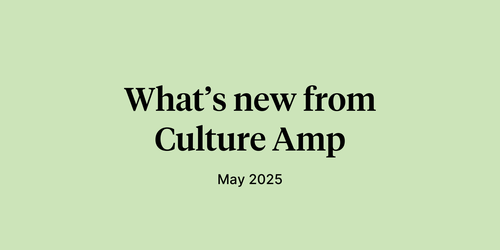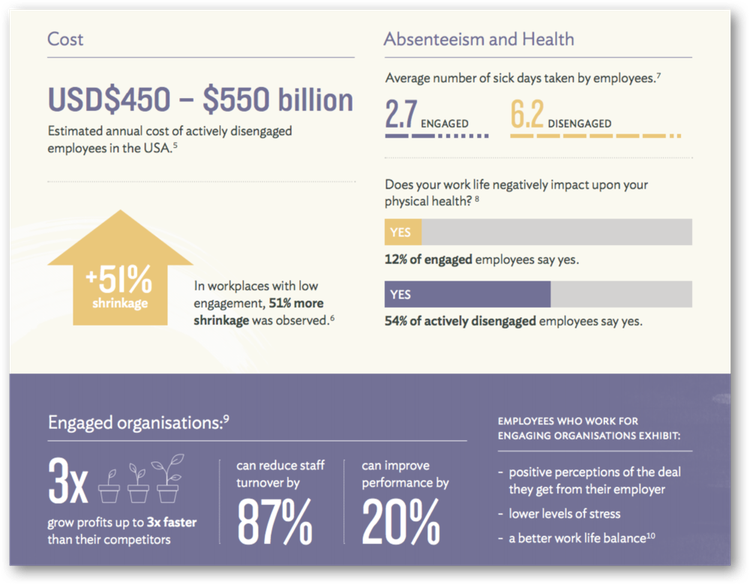
Article

We know communication in the workplace is important because it affects our ability to work together, and it affects employee engagement. To understand this connection, David Ostberg, Director of Insights at Culture Amp, and Chris Yeh, the co-author of The Alliance: Managing Talent in the Networked Age and co-founder of Allied Talent, presented research on communication and engagement in a one-hour webinar. What follows is an overview of the concepts and data they discussed.
Culture Amp defines employee engagement as the level of connection, motivation, and commitment a person feels for their organization. David explains, “Specifically, we measure engagement in our surveys with five key questions, which we call the Employee Engagement Index. It's a measure we use to identify those core aspects, and it's more than just employee happiness or employee satisfaction.”
Why does employee engagement matter? Engaged employees are likelier to stay with an organization, so you have less turnover. They also contribute to better company culture, are more productive, and take fewer sick days.

In the New Tech Benchmark, Culture Amp analyzed data from over 150 companies with responses from over 60,000 employees. Out of the questions asked in the engagement survey, there are ten top drivers of engagement. David says, “These are the areas that you need to be aware of as an organization because that's where you can improve aspects of your employee's work-life to improve their engagement.”
Three of the ten top questions driving employee engagement relate to communication. These include:

When comparing scores on five survey items that impact engagement, the impact of communication is clear. The chart below shows the top 10% of highly engaged companies versus the bottom 10%. The top four items all involve communication. For example, Culture Amp’s research has found that companies who get high scores on the first item not only direct resources well but do a great job communicating decisions about resources to the whole company.

In the next sections, we look at the importance of communication from the top and why a motivating company vision matters for employee engagement.
Leadership communication is a driver of employee engagement that is consistent not only in New Tech but across industries.
Chris says, “The things that really set the highly engaged employees and great managers apart are things that relate to communication. Someone has talked to you about your progress. Someone has encouraged your development. What's really interesting about that is that career development is really the tip of the spear when it comes to open and honest communication.”
When managers and employees can frankly discuss career development, they create a foundation for trust and higher engagement.
The things that really set the highly engaged employees and great managers apart are things that relate to communication. Someone has talked to you about your progress. Someone has encouraged your development. What’s really interesting about that is that career development is really the tip of the spear when it comes to open and honest communication.
Chris Yeh
Co-Founder of Allied Talent
Employee engagement starts when a person engages with an organization as a candidate. As David says, “It is then that you have the opportunity to really set expectations and create a level of trust, or ‘psychological safety,' that you are being honest and open with the individual regarding what the job is really about.”
To that end, Chris brings up the age-old interview question, “Where do you see yourself in five years?” as an example of what not to ask when you want to foster open and honest communication. He says, “When you use that question, you are essentially saying, ‘I now want you to lie to me and give me the answer that we both know you're supposed to give, so I can check the box and move on.’”
Instead of the five years question, Chris suggests asking candidates, “What job would you like to have after you leave this company?” This question comes from Kevin Scott, who was VP of engineering for LinkedIn when he first started using this question. It’s a bold question because it addresses upfront that the candidate might not spend their whole career at one company. “But by being willing to admit that, and being open and honest about that, it allows him to gather the information necessary to engage employees,” says Chris.
As a concrete example, Chris tells the story of Airbnb's CEO, Brian Chesky. “What Brian has done consistently is to figure out, how do I communicate the vision for what Airbnb should be? Several things go into it. The first, of course, is settling on a very simple story and then repeating it over and over again. The story for Airbnb is it's all about hospitality. It's not the hotel business. It's the hospitality business, and it's providing experiences, not just rooms,” Chris says.
Brian has been intentional about how the Airbnb story has been told from the beginning. But it’s not just the words of a CEO that matter. Chris says, “It's also the actions they take and the things they put in place so that that commitment is visible. One of the things that Brian did is he hired one of the animators from Pixar to storyboard the entire process, starting from the point at which a person decides, ‘Hey, I want to go on a vacation.’” By doing that, Chris took an abstract vision and provided a concrete way of looking at it. The storyboard sits in Airbnb headquarters, says Chris, and you can see it when you walk into the building. Providing multiple ways to communicate this vision has only made it stronger.
As David says, “Essentially, as leadership or as leaders, it's almost impossible to over-communicate strategy, direction, and relevant tactical details.” As Chris and David show throughout the webinar, communication is more than just talking to drive the point home. Effective communication that drives engagement is focused and strategic.
